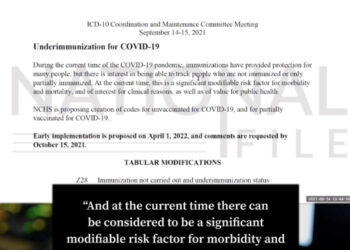As President-Elect Biden and his COVID Czar Jeff Zients contemplate another lockdown and whether to impose a mask mandate onto the COVID panic fatigued American people, yet another academic study proves what many, including President Donald Trump, suspected: Lockdowns cause more harm than good.
Dr. Ari Joffe, a specialist in pediatric infectious diseases at the Stollery Children’s Hospital in Edmonton, Canada, has authored a peer-reviewed paper that substantiates popular claims that lockdowns have consequences.
He is also a Clinical Professor in the Department of Pediatrics at University of Alberta in Canada.
Joffe has authored a peer-review academic paper titled COVID-19: Rethinking the Lockdown Groupthink that finds the repercussion harms caused by the COVID lockdowns are ten-times greater than any benefit that can be perceived.
“Initial data falsely suggested that the infection fatality rate was up to 2-3 percent, that over 80 percent of the population would be infected, and modelling suggested repeated lockdowns would be necessary,” Joffe said in an interview.
“But emerging data showed that the median infection fatality rate is 0.23%, that the median infection fatality rate in people under 70 years old is 0.05%, and that the high-risk group is older people especially those with severe co-morbidities,” Joffe continued.
“Once I became more informed, I realized that lockdowns cause far more harm than they prevent.” -Dr. Ari Joffe…” https://t.co/hnaVf6oFwA
— The HighWire (@HighWireTalk) January 11, 2021
Joffe said that emerging data on the subject of lockdowns – and their consequences – show a shocking set of so-called “collateral damage” issues caused by the lockdowns. He estimates that millions of people, globally, could easily be adversely affect by a continuation of the unnecessary practice, generally, for the public.
Among the issues Joffe cites in his study are:
- Food insecurity (82-132 million people)
- Severe poverty (70 million people)
- Maternal and under age-5 mortality from interrupted healthcare (1.7 million people)
- Infectious diseases deaths from interrupted services (millions of people with Tuberculosis, Malaria, and HIV)
- School closures for children (affecting children’s future earning potential and lifespan)
- Interrupted vaccination campaigns for millions of children
- Intimate partner violence for millions of women
He continues to list adverse effects as they pertain to high-income countries in delayed and interrupted healthcare, unemployment, loneliness, deteriorating mental health, increased opioid crisis deaths, alcoholism, suicide, and more.
Joffe also criticized the authoritative powers that kneejerked into supporting lockdowns, masks, and other draconian control techniques by pointing out that no formal cost-benefit analysis was ever performed.
“Dr. Ari Joffe, a pediatric infectious diseases physician and university professor based out of Edmonton, authored a research paper that concluded the costs of lockdowns are ‘at least’ 10 times higher than the benefits.” @TheTorontoSun https://t.co/6l7PoWydCJ
— IEDM – MEI (@iedm_montreal) January 12, 2021
“A formal cost-benefit analysis of different responses to the pandemic was not done by government or public health experts,” Joffe said. “Initially, I simply assumed that lockdowns to suppress the pandemic were the best approach. But policy decisions on public health should require a cost-benefit analysis. Since lockdowns are a public health intervention, aiming to improve the population wellbeing, we must consider both benefits of lockdowns, and costs of lockdowns on the population wellbeing. Once I became more informed, I realized that lockdowns cause far more harm than they prevent.”
Joffe urged a better self-education on the issue weighing heavily on a solid understanding of the risks and trade-offs involved. He suggested that approach would alleviate unreasonable fear with accurate information. “We need to focus on cost-benefit analysis – repeated or prolonged lockdowns cannot be based on COVID-19 numbers alone,” he said.
“We should focus on protecting people at high risk: people hospitalized or in nursing homes, in crowded conditions, and 70 years and older especially with severe comorbidities – don’t lock down everyone, regardless of their individual risk,” he concluded.



















